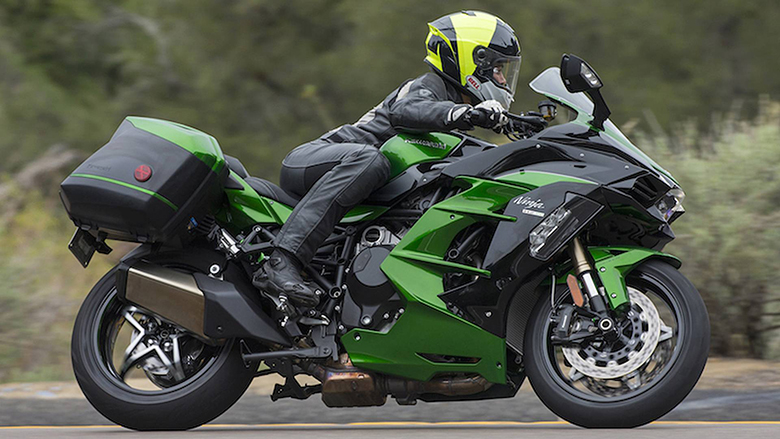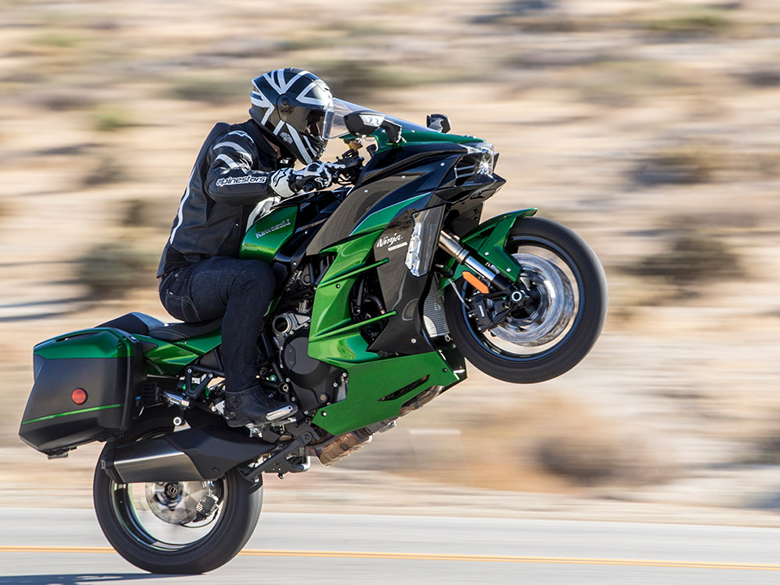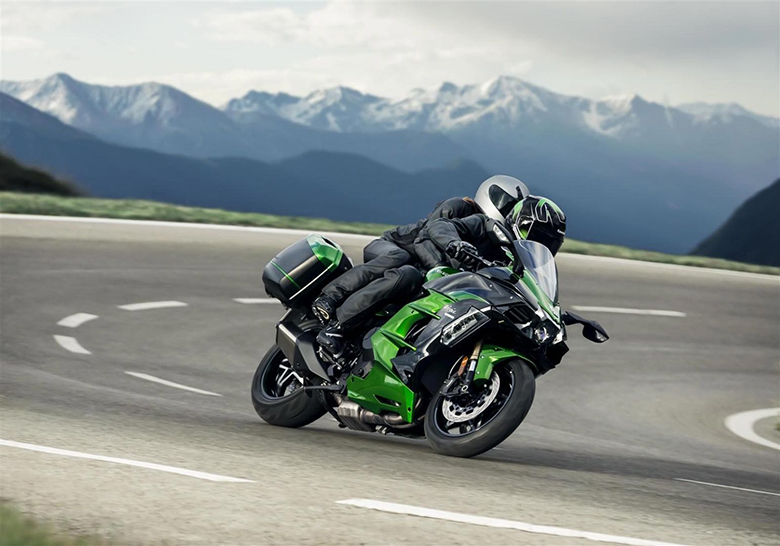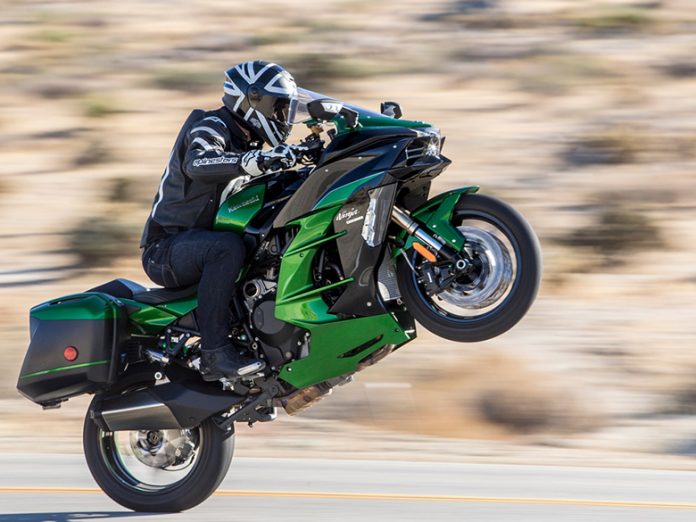The 2018 Kawasaki Ninja H2 SX SE Sports Motorcycle is another impressive example of a sports motorcycle. The Kawasaki brand brings the powerful sensory experience of a supercharged engine to sport touring, plus the bike is the best example of a balanced supercharged engine and fantastic body design. The Ninja H2 SX is available in Emerald Blazed Green / Metallic Diablo Black paint. Furthermore, the review of the 2018 Kawasaki Ninja H2 SX SE Sports Bike with its price and specification is written below.
2018 Kawasaki Ninja H2 SX SE Sports Motorcycle – Features and Price
Launch Control Mode
In racing, getting a burst start is very important and a few seconds can make a massive difference between hitting the mark. In slippery conditions, gaining a maximum speed requires precise control of both clutch and throttle.
The Launch Control Mode helps the rider get an excellent start by complementing high-level techniques with proper engine management. The system is used for the first time on Kawasaki’s KX450F that activates a separate engine map designed to offer a more efficient start off the line. The system is designed with the exact specifications used in factory racers competing in the AMA Supercross and motocross championships.

Lunch Control Mode can easily be activated with a simple press of a button on the handlebar. It map slightly retards ignition timing to help tame the engine’s strong torque and reduce wheel spin off the start. The mode is only active in the first two gears, and it automatically shuts off once the rider shifts into third gear. It gives the rider a great advantage when lining up at the gate and puts them in a better position to win.
Dual Throttle Valves
The late models in the sports category bikes often use large-bore throttle bodies to generate high power levels. Regardless of the oversized diameter throttle, when the rider suddenly opens the throttle, he will observe an explosive response of torque that is often difficult for the rider to handle. The dual throttle valve technology was designed to control the overall engine response while contributing to performance.
In fuel-injected models, throttle bodies typically come with one throttle valves per cylinder. On such models with dual throttle valves, there are two throttle valves per cylinder. Additionally, they are physically linked to the throttle grip and controlled by the rider. There is a second set of valves that opens and closes by the ECU that precisely regulates intake airflow to ensure a natural and linear response. Thanks to the smooth air passing through the throttle bodies becoming smoother, the overall combustion efficiency is improved, and the general power is increased.
Like the Kawasaki engine management technology, Dual Throttle Valves was designed to offer natural-feeling riding to the rider. They are featured on many of the Kawasaki models.
Horizontal Back-Link Rear Suspension
Compared to Kawasaki’s traditional Uni-Trak rear suspension system that attaches the shock unit vertically with Horizontal Back-link rear suspension, now the engineers have used the horizontal shock unit. One can find the original suspension arrangement very close to the motorcycle’s center of gravity contributing to mass centralization. Since no linkage or any shock unit is protruding beneath the swingarm, it frees up enough space for the large exhaust pre-chamber. Thanks to the larger pre-chamber, silencer volume can easily be reduced and the heavy exhaust components can be intense closer to the center of the motorcycle. Thus contributing to mass centralization efficiently. It helps in a more excellent handling and better stability of the 2018 Kawasaki Ninja H2 SX SE Sports Motorcycle.

Another fantastic benefit is that the shock unit is positioned away from exhaust heat. Because it is difficult for the heat from the exhaust system to adversely affect suspension oil and gas pressure. The horizontal back-link rear suspension offers many other secondary benefits as well.
Assist & Slipper Clutch
The Assist and Slipper Clutch uses two types of cams, i.e., Assist Cam and Slipper Cam, to either drive the new clutch hub and operating plate together or apart.
In normal condition, the assist cam functions as a self-servo mechanism, pulling the new clutch hub and an operating plate together to compress the clutch plates. It allows the total clutch spring load to be reduced thus resulting in the lighter clutch lever feel while using the clutch.
Whenever rider excessively applies engine braking – as a result of quick downshifts, the slipper cam comes into play and forces the clutch hub and operating plate apart. It relieves pressure on the clutch plates to minimize the back torque and help in preventing the rear tire from skidding and hopping.
KTRC (3-Mode)
The three modes of KTRC combine with the latest traction control of Kawasaki technology to both 1-mode KTRC that offers maximum stability in the slipper situation while preventing wheel slip. The S-KTRC helps maintain the optimum traction in sport riding conditions by preventing the rear wheel slip ratio during acceleration into a solo system.
The convenient handle switch helps the rider instantly change the traction control by selecting one of the three modes. The first two modes maintain optimal traction during cornering and they are designed with sport riding in mind. They ensure the sharp acceleration out of corners by maximizing forward drive from the rear wheel. They vary from each other in the amount of intervening. The Mode 1 is set for dry and good-grip road conditions and it helps maintain an ideal slip ratio to guarantee optimum traction.
Mode 3, on the other hand, like 1-mode KTRC, reduces power to allow grip to be regained when the rear wheel spin is detected. It is best when riding in slippery conditions or wet. It will enable the rider to change traction control character easily. 3-mode KTRC is Kawasaki’s most advanced engine management system.
ABS
If any sudden application of the brakes or braking on low-grip surfaces, such a wet asphalt, may cause a bike’s wheel to lock up and slip. The Anti-Braking System was developed to prevent such incidents. The Kawasaki ABS is controlled by high precision and highly reliable programming based on thorough testing of numerous riding situations. While ensuring a stable braking performance, it offers rider reassurance that contributes to a greater riding enjoyment.

To meet the unique requirements of a confident riders, specialized ABS is also available. Like, KIBS (Kawasaki Intelligent anti-lock Brake System) is a high-precision brake system designed specifically for supersport models. It allows the rider to enjoy a wide range of sports riding styles. By linking the rear and front brakes, K-ACT (Kawasaki Advanced Coactive-braking Technology) ABS offers the confidence to enjoy touring on heavyweight models. The brand is continually working on the development of other advanced ABS.
Electronic Cruise Control
Electronic Cruise Control helps the desired speed to be maintained with the simple press of a button. Since the rider does not have to control the throttle, this intelligent system allows relaxed cruising. It reduces stress on the right hand when traveling long distances, thus contributing to the high level of riding comfort.
Electronic Cruise Control is also present on Kawasaki Vulcan 1700 and NV1700 Series cruisers. Like the 2018 Kawasaki Ninja H2 SX SE Sports Motorcycle, these modes come with an Electronic Throttle Valve system that allows the throttle valves are not actuated directly by twisting the throttle grip. It is how Electronic Cruise Control can automatically adjust engine power to maintain vehicle speed during ascending or descending grades are encountered.
Economical Riding Indicator
Using the highly accurate electronic control for engine management, Kawasaki models achieve the highest level of fuel efficiency. However, fuel consumption is greatly affected by the throttle use, selection of gear and some other elements under the rider’s control. The Electronical Riding Indicator is a function that indicates when current riding conditions are consuming a low amount of fuel. It constantly monitors the fuel consumption at any speed of a bike or an engine, riding conditions or throttle position. When the fuel consumption is low for a given rate, an ECO mark appears on the instrument panel’s LCD screen. By riding on the ECO mark remains on, fuel consumption can be reduced.
Kawasaki Intelligent anti-lock Brake System (KIBS)
The engineers of Kawasaki developed KIBS to handle the particular handling characteristics of supersport motorcycles. It ensures highly-efficient braking with minimal intrusion during hard sport riding. It is the first mass-production braking system that links the ABS ECU (Electronic Control Unit) and engine ECU.
In addition, the front and rear wheel speed KIBS monitors front brake caliper hydraulic pressure, clutch actuation, engine speed and gear position. This diverse information is then analyzed to determine the ideal front brake hydraulic pressure. With the help of accurate control, the large drops in hydraulic pressure seen on standard ABS can be avoided. Furthermore, the tendency on supersport models for the rear wheel to lift under heavy braking can be intimidated, and rear brake controllability can be maintained when downshifting.
Power Modes
Power modes allow the rider to select a choice between Full and Low power easily. The Full Power is unrestricted; in Low Power mode maximum capacity is limited to approximately 75-80% of Full. The response is also milder in Low Power mode. The rider may opt to use the Low Power mode for rainy conditions or during city ride and Full Power when riding on highways and tracks.
Alongside the 2018 Kawasaki Ninja H2 SX SE Sports Motorcycle, it is also available in Ninja ZX-14R, Versys 1000 and ZZR1400. When combined with a 3-mode KTRC traction control system, it provides eight combinations that suit the variety of riding conditions.
Supercharged Engine
The 2018 Kawasaki Ninja H2 SX SE Sports Motorcycle comes with the supercharged engine that the worthy engineers of Kawasaki have developed. The engine is capable of delivering high output while maintaining a compact design. The key to achieving extraordinary performance lies in the engine’s supercharger; a motorcycle-specific unit designed entirely in-house with technology from Kawasaki’s Gas Turbine and Machinery Company, Corporate Technology Division, and Aerospace Company.
One of the most excellent benefits of designing the supercharged engine is to ensure that its design matches the engine’s characteristics that engineers could achieve high-efficiency operation over a wide range of conditions. Something that would not be possible to drop in or trying to adapt an aftermarket automotive supercharger.
The importance of high efficiency in the supercharger is that, as the air is compressed, power rubbing heat gain is minimal. While many superchargers can offer high-efficiency operations in a minimal range of conditions, Kawasaki’s supercharger provides high productivity over a wide range of pressure ratios and flow rates. The wide range of efficient operations easily translates to strong acceleration. The high efficiency and minimal heat gain mean that an intercooler was unnecessary, significantly saving weight and space and allowing the engine’s compact design.
Kawasaki Engine Brake Control
The Kawasaki Engine Brake Control system helps the rider to select the amount of engine braking that they prefer. When this system is activated, the engine braking effect is minimized while offering less interference when riding on the circuit.
Enhanced Chassis Orientation Awareness (IMU)
The power of Kawasaki’s cutting-edge electronics has always been highly sophisticated programming that uses minimal hardware that offers an ECU an accurate real-time picture of what the chassis is doing. Kawasaki’s proprietary dynamic modeling program offers skillful use of magic formula tire mode. It examines changes in multiple parameters, thus enabling to take into account changing road and tire conditions.
The addition of an IMU enables inertia along 6 degrees of freedom to be monitored. Acceleration along longitudinal, transverse and vertical axes increases roll rate and pitch rate are measured. The ECU calculates the yaw rate, and it helps present a clearer real-time picture of chassis orientation thus enabling even more precise management for control at the limit.
With the addition of IMU and the latest Kawasaki modeling software, the electronic engine and chassis management technology take the step to the next level thus changing from setting-type and reaction-type systems to feedback-type systems to deliver even greater levels of riding excitement.
Kawasaki Quick Shifter (KQS)
It is designed to help riders to maximize their acceleration on the circuit by enabling the clutchless upshifts with the throttle fully open; the KQS detects that the shift lever has been actuated and it sends a signal to the ECU to cut ignition so that the next gear can be involved without having to use the clutch. For some models, when the race kit ECU is used, clutchless downshifts are also possible.
2018 Kawasaki Ninja H2 SX SE Sports Motorcycle – Price
The 2018 Kawasaki Ninja H2 SX SE Sports Motorcycle is available at $25,299.
2018 Kawasaki Ninja H2 SX SE Sports Motorcycle – Technical Specifications
Engine
| Displacement | 998cc |
| Type | 4-stroke, In-Line Four |
| Bore and stroke | 76 mm x 55 mm |
| Compression ratio | 11.2:1 |
| Cooling | Liquid |
| Valve system | DOHC, 16 valves (4 valves-per-cylinder) |
| Fuel system | Fuel injection: 40mm x 4 including dual injection |
| Ignition | Digital |
| Lubrication | Forced lubrication (wet sump), including oil cooler |
Brakes
| Front: Type | Dual semi-floating 320 mm discs |
| Front: calipers | Dual radial-mount, monobloc, opposed 4-piston |
| Rear: type | Single 250 mm petal disc |
| Rear: calipers | 2-piston caliper |
Dimensions
| Overall length | 2,135 mm |
| Overall width | 775 mm |
| Overall height | 1,260 mm |
| Wheelbase | 1,480 mm |
| Ground clearance | 130 mm (5.1 in.) |
| Seat height | 835 mm |
| Curb mass | 260 kg |
| Fuel capacity | 19 liters (4.2 gals.) |
Drivetrain
| Transmission | 6-speed, return dog-ring |
| Final drive | Chain |
| Primary reduction ratio | 1.480 (74/50) |
| Gear ratio: 1st | 3.077 (40/13) |
| Gear ratio: 2nd | 2.471 (42/17) |
| Gear ratio: 3rd | 2.045 (45/22) |
| Gear ratio: 4th | 1.727 (38/22) |
| Gear ratio: 5th | 1.524 (32/21) |
| Gear ratio: 6th | 1.348 (31/23) |
| Final reduction ratio | 2.444 (44/18) |
| Clutch | Wet multi-disc, manual |
Frame
| Type | Trellis, high-tensile steel, with Swingarm Mounting Plate |
| Wheel travel: front | 120 mm (4.7 in.) |
| Tire: front | 120/70ZR17M/C (58W) |
| Wheel travel: rear | 139 mm |
| Tire: rear | 190/55ZR17M/C (75W) |
| Caster (rake) | 24.7° |
| Trail | 103 mm |
| Steering angle (left/right) | 30° / 30° |
Performance
| Maximum Power | 147 kW {200 PS} / 10,000 or 154 kW {210 PS} / 10,000 with RAM air |
| Maximum Torque | 137.0 N.m {14.0 kgf.m} / 9,500 |
Suspension
| Front Suspension | 43 mm inverted fork with rebound and compression damping and spring preload adjustability, and top-out springs |
| Rear Suspension | New Uni-Trak, gas-charged shock with piggyback reservoir, compression and rebound damping adjustability, remote spring preload adjuster, and top-out spring |
Details
| Warranty | 12 months warranty |




